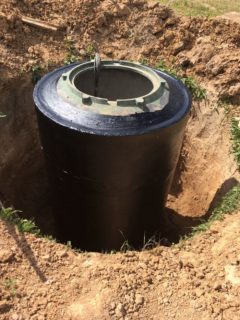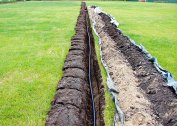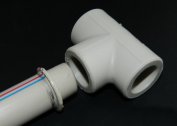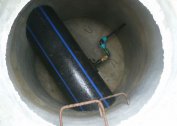It is necessary to waterproof the intake structure so that its depressurization does not occur. It will also protect the water well from harmful substances that contain groundwater. If everything is done correctly, pollution will not get into the tank and the source will not lose clean liquid.
The need for waterproofing the well from groundwater
In accordance with the regulations of SNiP, all drinking tanks require careful coating with a layer of waterproofing, which protects against the destructive and polluting effects of subsurface water.
Soil flows can not only spoil the contents of the well, they negatively affect the structure. Sealing the seams of the well trunk protects it from destruction and maintains the purity of water.
Wells in wet soils are covered with waterproofing so that it exceeds the level of subsurface sources by 0.5 m.
If high-quality waterproofing of the well structure has not been carried out, this can lead to the appearance of fungal deposits on the internal walls of the structure, which can provoke complete or partial destruction of the well trunk.
Waterproofing materials
Internal and external waterproofing of the well is carried out:
- membrane and roll building materials;
- two-component compounds;
- smear preparations;
- mineral astringent mixtures;
- bitumen-polymer mastics.
The choice of building material depends on the method of sealing, financial capabilities and the time of waterproofing - it goes at the stage of construction of the well or after. By this principle, a set of tools is also selected.
Effective waterproofing methods
It is possible to seal a well with drinking water from pollution from the outside or from the inside. For each option, its own most suitable methods have been developed. But in any case, first joints and cracks are sealed, and then general waterproofing is already carried out.
Outdoor work
If the work is carried out during the repair of the hydraulic structure, you will need to prepare the base. To do this, the well is freed from the ground to a depth of three meters, the destroyed concrete is knocked down with a hammer, the surfaces are washed and cleaned, the protruding reinforcement is covered with a rust converter. Only after this can the main work begin.
External insulation from groundwater can be carried out by the following methods:
- laying rolled materials;
- using penetrating compounds;
- by spraying mixtures with special guns.
After the coating is completed, the space around the well is filled with a mixture of sand, clay and gravel, rammed, a blind area is created. You can make a clay castle.
It is more profitable to carry out all these works at the stage of arranging a well structure. It is inexpedient to waterproof the finished structure from the outside below three meters - the labor costs will be too great.
Internal sealing
The waterproofing of the well from the inside from the groundwater requires drainage. If the flow rate is increased, it will be necessary to conduct continuous pumping with pressure equipment.
The surface of the shaft shaft is pre-cleaned of dirt and polished. Cracks and crevices are slightly widened, treated with a metal brush and sealed with a cement-polymer composition.
To seal the water shaft from the inside, you can apply:
- Cement mixes - prepared or diluted independently.They are applied to the surface with a spatula in two layers of 4 mm each.
- Bitumen and gasoline paint. The mine is covered with a three-layer composition in stages, since each one dries for 12 hours.
- Cement-polymer compositions, for example, from cement powder and water glass. Similar materials are applied in three layers with a spatula.
Sealing polymer materials are the most expensive, but at the same time they are most effective and last up to half a century. The best recommendations for a film polymer membrane. It’s easy to apply. Initially, the inside is covered with mastic and allowed to dry for 24 hours. Then paste over with a film. To do this, you need to expand the roll, press the membrane to the surface and expel air from under it, paste the entire trunk.
The bottom in the intake springs is not waterproofed, because through the filter installed there, the tank is filled with water. Protective work is carried out if the structure is, for example, cumulative or viewing. Also, full waterproofing is required for dry well shafts, used, for example, as caissons.
It is possible to carry out waterproofing work, although it is laborious, independently. But this must be done. Due to insufficient sealing, one will have to spend money on expensive repairs of one or several parts of the structure. It is better to carry out sealing even in the process of assembling the well. But if this did not work out, it is possible to put water protection in the existing water intake.





